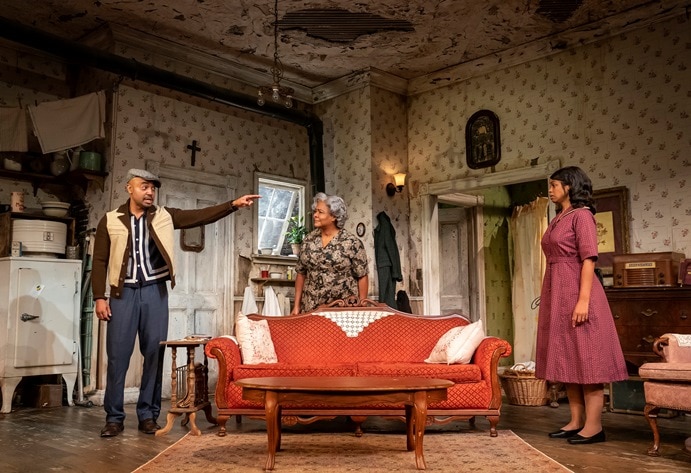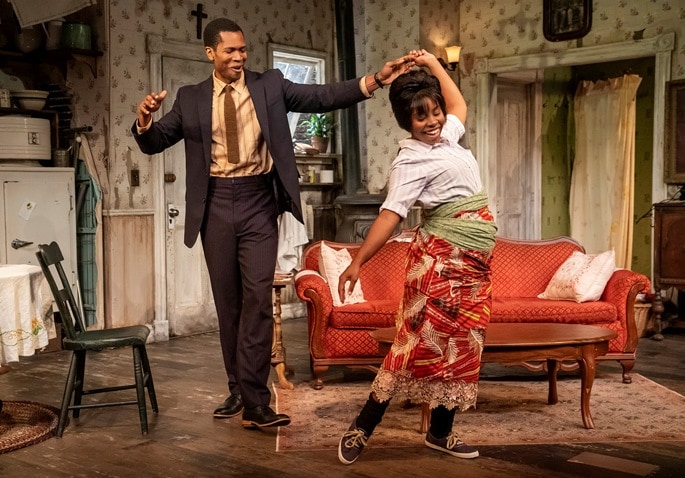Lorraine Hansberry’s classic 1959 American drama A Raisin in the Sun was the first play written by a Black woman to have a Broadway production; it’s now the first work by the acclaimed playwright to be presented at Off-Broadway’s The Public Theater. Inspired by her father’s 1940 lawsuit against racially restrictive housing covenants in Chicago, the title of the play was taken from the poem “Harlem” by Langston Hughes, published in 1951: “What happens to a dream deferred?/Does it dry up/like a raisin in the sun?/ . . . Maybe it just sags/like a heavy load./Or does it explode?” Here, under the direction of Robert O’Hara, it does.

Set in a cramped, decaying, and roach-infested apartment on the South Side of Chicago (scenic design by Clint Ramos), five years before the passage of the Civil Rights Act in 1964, Lena Younger is about to receive a $10,000 check from her late husband’s life insurance policy, with which she wants to buy a house for her family, so she can give them more space, move them away from their rat-ridden streets, and give her grandson Travis a better future, despite a warning from their nosy neighbor Mrs. Johnson about the dangers of buying into a predominantly white area. Her 20-year-old daughter Beneatha (Bennie), a medical student with a mind of her own, needs money for her college tuition, and her adult son Walter Lee, working an unfulfilling job as a chauffeur and experiencing troubles in his marriage to Ruth, has dreams of using it to become a wealthy entrepreneur by partnering in a liquor store his friends Bobo and Willy.
The central family dynamics, financial strife, and racial struggles come to a head when Ruth is faced with an unexpected pregnancy, Bennie is torn between the two fellow students she is dating (the rich and assimilated intellectual George Murchison and the proud Nigerian native Joseph Asagai), Lena puts a down payment on a house in a white neighborhood (where Karl Lindner, the head of the “welcoming” committee, makes it clear they are not welcome and makes an offer to buy back the house), and Willy absconds with the remaining insurance money, which Walter had appropriated for his now-stolen investment. Despite the serious conflicts and setbacks, in Hansberry’s affirming and optimistic but still uncertain ending, they all make the tough decisions that unify them, prove their integrity, and offer the prospect of hope for the future in their quest for identity, equal opportunity, and the American Dream.

Under O’Hara’s signature in-your-face direction, there are a number of theatrical reworkings and additions to the original script in his blatantly aggressive and provocative style. Those include the deafening decibel level of the family arguing and talking over each other instead of listening to one another, making it difficult for the audience to hear what they’re saying; the recurrent apparition of the ghost of Lena’s husband, signaled by surreal lighting (by Alex Jainchill) and sound (by Elisheba Ittoop), which suggests that the strong Younger matriarch is driven by the patriarch; and a distracting and unnecessary off-stage sex scene between Walter Lee and Ruth, with audible groans from the couple and an overly loud voiceover of their conversation in bed (both with sexist implications of male dominance and female acquiescence).
In addition, Walter Lee is portrayed as an incessant drinker, staggering and downing bottle after bottle of beer throughout the show. Then in a climactic metatheatrical break through the fourth wall, he takes the spotlight center stage for an incendiary direct-address diatribe that insults the theatergoers for being there and expecting the cast to “perform” for them, while crumpling and throwing the show’s Playbill into the audience. Would he prefer that people not attend or support the production? Following that, he is suddenly and uncharacteristically sober, “plain,” and “proud,” refuses to sell out to Lindner, and, in the words of his mother, has become a man. The arc of the character’s development, as seen here, defies credibility. And in a shocking closing scene (video design by Brittany Bland), O’Hara’s interpretation annihilates any possibility for the hope that Hansberry left open-ended.

Whether you’re a Hansberry purist or a fan of O’Hara’s radical new vision, the cast delivers the perspective they’re given with committed performances that capture the conflicting ideas and personalities of their characters, led by the outstanding Tonya Pinkins as a determined, tough, and resilient, devoted and loving Lena, who honors God, the memory of her husband, and her family, and does what she believes will best advance the future. Francois Battiste brings all the anger, frustration, and disappointments to his powerhouse portrayal of Walter Lee, while Mandi Masden as Ruth is exhausted from her familial responsibilities, distressed by her inability to alleviate the unhappiness of her husband, concerned about bringing another child into their meager situation, and too often reduced to yelling or sobbing. Paige Gilbert as Beneatha represents the viewpoint of a younger generation, who rejects both religion and assimilation, and chooses to embrace her education and her African heritage (costumes by Karen Perry; hair and wig design by Nikiya Mathis) rather than the material comforts of being a rich man’s housewife, as offered by her diametrically opposed suitors (John Clay III as Joseph Asagai and Mister Fitzgerald as George Murchison).

Rounding out the fine company are Toussaint Battiste (the real-life son of Francois Battiste) and Camden McKinnon (at the performance I attended) alternating as the young Travis; Jesse Pennington as Lindner, the only white character in the play who offers payment to the Youngers to ensure racial exclusivity in his neighborhood; Calvin Dutton doubling as the ghost of Lena’s husband and as Bobo, who gives Walter Lee the bad news about the unseen Willy’s theft of their money; Perri Gaffney, who provides a touch of humor as the busybody Mrs. Johnson; and Bjorn Dupaty and Christopher Marquis Lindsay as the Moving Men.
Hansberry’s psychological complexity and social commentary in A Raisin in the Sun still resonate in The Public’s production, though much of the naturalism and expressive subtlety of her writing are lost in the updated and sometimes heavy-handed directorial choices that not only verbally affront the viewers but don’t trust them to understand the issues or to recognize their ongoing relevance.
Running Time: Approximately three hours, including an intermission.
A Raisin in the Sun plays through Sunday, November 20, 2022, at The Public Theater, 425 Lafayette Street, NYC. For tickets (starting at $70, plus fees), go online. The use of a face mask is strongly encouraged but only required at all Tuesday evening and Saturday and Sunday matinee performances.





